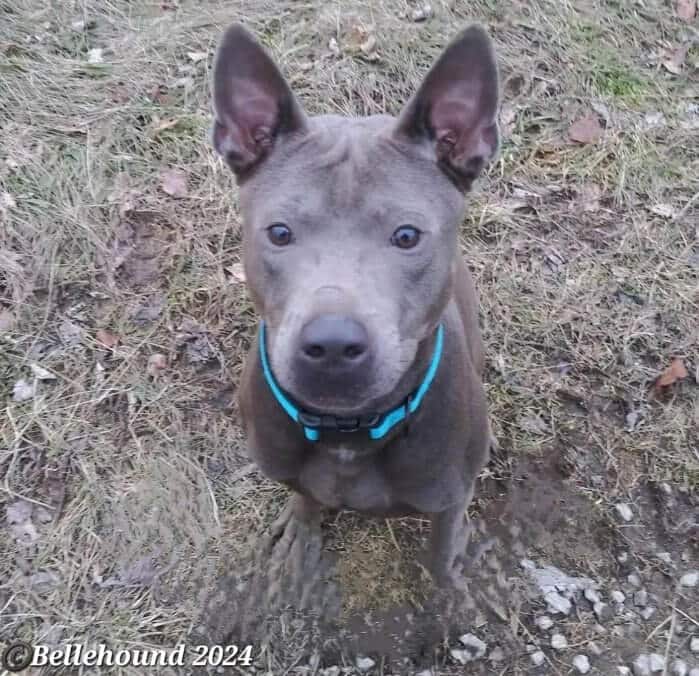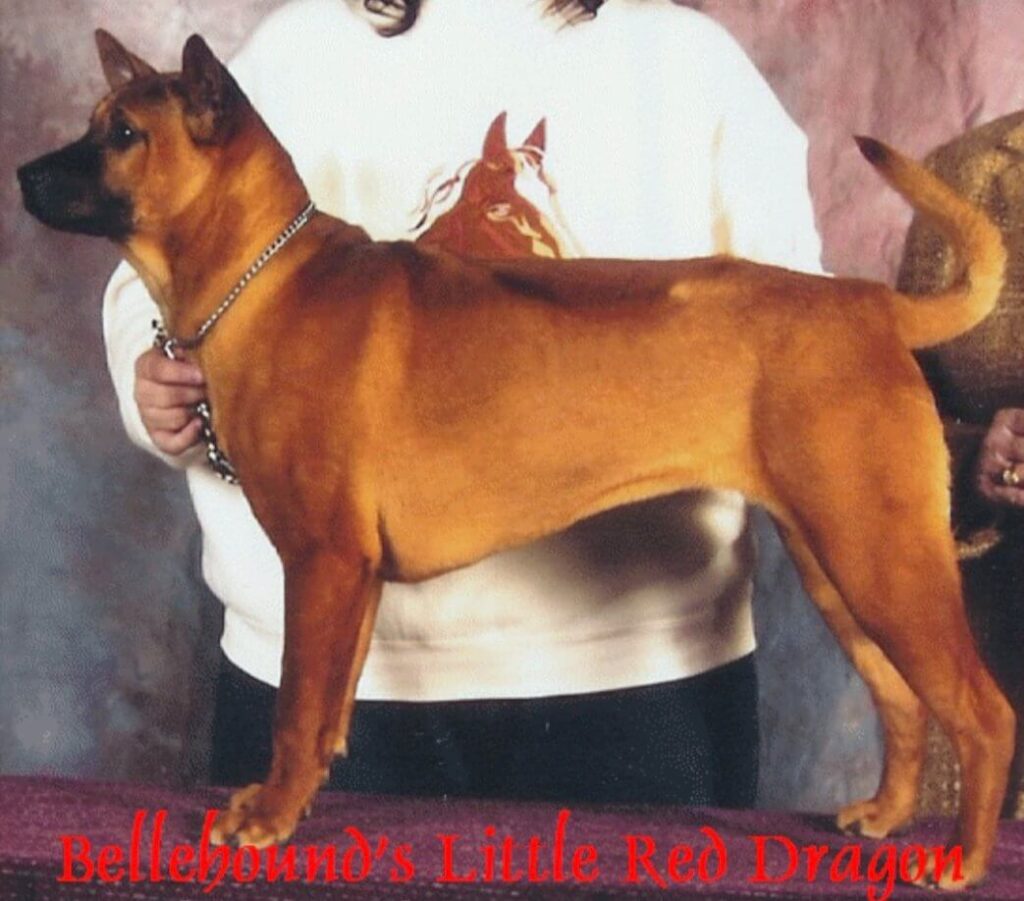


Home » Meet the Breed: 5 Things to Know About the Thai Ridgeback

Featured photo: ©Bellehound 2018
Among the numerous rare breeds that have gotten themselves more attention in the public eye by going through the process to become officially recognized by kennel club registries, one of the more intriguing is the Thai Ridgeback. This breed possesses a similar type of ridge along its spine as the popular Rhodesian Ridgeback, but this Asian breed is quite different from its African cousin in many ways.
Representations of the breed appeared in early cave drawings in Eastern Thailand—many moons ago. Today’s dogs bearing a striking resemblance to their ancestors and typically stand between 20 and 24 inches tall at the shoulder and weigh between 35 and 75 pounds, depending on gender and pedigree. A long life expectancy of between 14 and 15 years is not uncommon for this little-known breed.
Like many purebred dogs that aren’t commonly seen in North America, the Thai Ridgeback comes with its own fun quirks. It’s therefore important for potential owners to understand its idiosyncrasies and know what they are getting into before welcoming a member of this captivating breed into the home.
Here’s a look at five things to know about the Ridgeback that hails from Thailand.

Thai Ridgeback ownership can be very rewarding, but it is also not for the faint of heart. The President of the Association of Thai Ridgeback Owners and Fanciers, Cathleen Combs, says she believes people should have lived with another primitive breed or something “gamey,” like a terrier, if they are getting into the breed for the first time.
Cathleen herself has had Basenjis before and says owning a Thai Ridgeback makes the Basenjis seem almost like Border Collies. What she means by this comparison is that while Border Collies aren’t necessarily an “easy” breed, they’re far more amenable to training than a lot of the more primitive breeds. She should know, too, as she’ s had Thai Ridgebacks since 2000 and Basenjis since 1996.
With the right work put in, though, new owners can have success with a Thai Ridgeback. “They definitely should do their homework and meet the breed prior to purchasing, which I know is hard considering it’s a relatively ‘rare’ breed,” Cathleen says. “But it’s better to meet them, if you can, as well as talk to multiple owners. This isn’t a carbon copy breed, and when it comes to life experiences with them, they’re all vastly different.”
And it is important to find the right breeder who will be truthful and transparent with the new owners about the breed. “The majority of the dogs that come/came into rescue came in due to a ‘greeder-breeder’ telling them all of the good things the owner wanted to hear, i.e., candy-coating the breed and not telling the cons of living with the breed,” Cathleen explains. “A lot of owners simply got in over their heads.”

That’s right. One of the biggest hallmarks of this breed is the ridge of hair on its back. But the moniker which gives the breed its name does not mean that every dog has that physical characteristic. In one litter, it is possible to have both ridge-backed and ridgeless puppies. Eight different types of ridges are deemed acceptable; these are Needle, Saddleback, Lute, Po Leaf (Thai Plant Leaf), Panom (Praying Hands), Arrow, Violin, and Bowling Pin.
Colorwise, the Thai Ridgeback comes in four colors: red (light red to deep mahogany, with or without a black mask); black (jet black, seal, and/or chocolate—which falls under this color description—a deep, rich, black is preferred); blue (silver, gray to gun metal blue); and yellow (fawn to Isabella).
Where the tongue is concerned, there can be black/blue pigmentation, either solid or spotted throughout the mouth. “There can be mottled/spotted tongues.” Cathleen explains. “The blues and yellows will have diluted, or lavender-colored, spots on their tongues, and some have no pigmentation on them at all.” That’s just one of many unique things about the breed.
Another unique feature is the breed’s uncommon estrus cycle. “They also only come in season once a year, normally in the fall,” Cathleen explains. “So, they’re on their feet and mobile by spring, depending on which side of the equator you’re on.”

If you are in search of a dog that embodies versatility, look no further than the Thai Ridgeback. The main purpose of the breed back in Thailand was to be used for sentry work—basically as a guard dog, but not quite in the same way that a German Shepherd Dog or a Doberman Pinscher is used.
This breed has also been employed as a carting and hunting dog, with the ability to put its propensity to climb trees and jump fences into action. With its strong prey drive, it is a fearless protector that is afraid of nothing, including hunting wild pigs and other vermin, and keeping cobras at bay.
Thai Ridgebacks are nonetheless very in-tune with their people. “At the same time, they know when you’re off your game, and they will take it and run with it,” Cathleen shares. “If you give them an inch, they’ll take a mile.”
Cathleen reports that the breed has a few qualities that can make it very appealing in the right home. “They are also very loving, very clean (they clean themselves like cats do), and quiet,” she says. “They are not a barky breed, and when they bark, it’s because something is not right, and it’s worth taking a look at.” The breed doesn’t tend to give many false alarms, and quiets down quickly if it feels it has done so at any point.
“On that same end, the garbage cans by day become the boogeyman at night,” Cathleen shares. “But once they realize there are no perceived threats, they will settle back down quickly.” When this breed is left alone for any length of time, it is important to keep these dogs properly contained. But that can be easier said than done. As Cathleen explains, “They are a breed that benefits from crate training, but also note they are escape artists.”
“So, before you spend tons of money buying cheaper, inferior crates, spend the money and buy a good one,” Cathleen suggests. “I have three High Anxiety IMPACT crates and I do not get a kickback for advertising. It will save you so much money in the long run.”

The Thai Ridgeback can live, and perhaps even thrive, in a family setting. But that is not necessarily what they are most after. Because of their primitive, ancient roots, they could probably do just fine without people at all. But when they do find who they believe is truly for them, it is by their own accord.
“They’re a primitive, ancient breed that could survive and thrive without humans if they had to,” Cathleen concedes. “These dogs aren’t like other breeds that have grown up in Westernized civilizations, for centuries, and that gets them into trouble, and also misunderstood. They are a very one-person dog; not saying they can’t live in a family setting, but they pick their human. They are aloof with strangers by nature, and they need to warm up to you, not the other way around, and it shouldn’t be forced.”
The way that family gatherings are held, especially after initially introducing a Thai Ridgeback to the household, should be planned with regard given to the nature of the animal. As Cathleen explains, “The breed typically doesn’t like people coming and going in and out of their house, which can be hard when you have children and they have friends always coming and going.
Thai Ridgebacks are, by nature, very territorial and protective, but they will fail miserably at Schutzhund training. As with any breed, you can’t change a dog’s genetics and what it was bred to do for centuries, so keep that in mind.
Keeping other animals around the house, especially of the same sex, is not advised. “The breed is very same-sex aggressive, and just because they grew up with your cat or other small dog, or same-sex dog, doesn’t mean they will always remain friends,” Cathleen emphasizes. “I never leave my Thai Ridgeback(s) unattended with my Siamese cat or Basenji(s), because very expensive vet bills taught me to always err on the side of caution now.”

Many first-time Thai Ridgeback owners have, unfortunately, come across their four-legged friend in an animal shelter. New owners, however, don’t always realize that this breed can be too smart for its own good. Sadly, the breed is widely misunderstood in a shelter environment and will mentally shut down fast there, leaving a dog’s future in peril due to no fault of its own.
“In training, you have to convince them that what you want them to do is what they really wanted to do,” notes Cathleen. “They pick up commands quickly, but also become bored just as quickly. So, repetition, which works great with Golden Retrievers and other breeds that were specifically bred to work for man, will not work for a Thai Ridgeback. They will get bored quickly and ignore you.”
There is no golden egg you can provide a Thai Ridgeback with that will make the dog want to do something, either. What is your idea must also be their idea. “If a Thai Ridgeback doesn’t want to do it, you can’t make them do it—it doesn’t matter how high-value of a treat you have,” according to Cathleen. “They’ll actually shut down if you use harsh punishment. It’s best to keep them on-lead in unfenced areas, unless you don’t mind waiting for them to decide they want to come back to you on their timeframe and not yours.”
Yet, as Cathleen has stated multiple times, every individual within the breed is just that—individual—and there is no one-size-fits-all edition of the Thai Ridgeback. “Some Thai Ridgebacks have made exceptional Medical Alert Service Dogs, as well as excelled in Search and Rescue recovery,” she shares. “But both of those jobs took intense training, so it’s not the norm for the breed to do those jobs. They are a high-energy breed, so keep that in mind.”
The Thai Ridgeback’s grooming needs, on the other hand, are minimal. They actually molt their coat more like a bird than a dog. To inexperienced owners, this can look like mange, but it doesn’t require a trip to the vet! The shedding, however, must still be accounted for to some extent. As with all dogs, regular bathing, ear cleaning, and nail trimming are essential.
For those who have done their homework and have decided the Thai Ridgeback is the right dog to share life’s journey, it is important to be connected with a reputable breeder and become aware of what is in the family lines from which you are obtaining the dog.
The Thai Ridgeback can suffer from GDV (bloat) and also carries the gene for Congenital Dermoid Sinus (CDS), which the Rhodesian Ridgeback and Vietnamese Phu Quoc Ridgeback also carry. Ridgeless dogs are not exempt from this, either. “DSC needs to be removed by a skilled surgeon, because if left untreated, they can rupture, turn into sepsis, and kill your dog,” Cathleen emphasizes. “This is why it is of the utmost importance to find a reputable, ethical breeder who does genetic health testing prior to breeding a litter… the breed should be health-tested for hip dysplasia, thyroid, PRA, and PPM. Seizures are now being found in puppies, and alopecia is sometimes seen in the dilute-colored dogs.”
It is strongly advised to check the OFA website (https://ofa.org/chic-programs/browse-by-breed/?breed=TR) to become familiar with the health screenings and testing statistics for the Thai Ridgeback and all recognized breeds.
